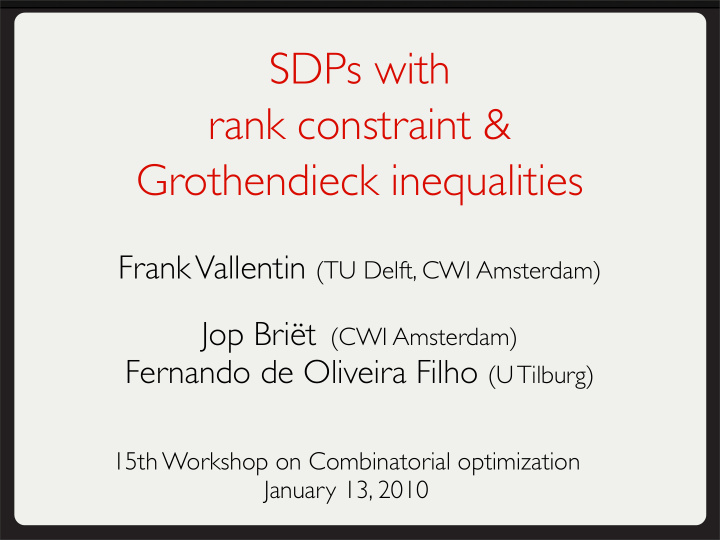



SDPs with rank constraint & Grothendieck inequalities Frank Vallentin (TU Delft, CWI Amsterdam) Jop Briët (CWI Amsterdam) Fernando de Oliveira Filho (U Tilburg) 15th Workshop on Combinatorial optimization January 13, 2010
Overview 1. The problem 2. SDP relaxation 3. Approximation algorithm http://arxiv.org/abs/0910.5765 http://arxiv.org/abs/1011.1754
1. The problem image credit: Sturmfels, Uhler
interaction graph G = ( V, E ) symmetric matrix A : V × V → R � � � A ( u, v ) f ( u ) · f ( v ) : f : V → S r − 1 SDP r ( G, A ) = max { u,v }∈ E S r − 1 = { x ∈ R r : x · x = 1 } graphical Grothendieck problem with rank- r constraint
� � � A ( u, v ) f ( u ) · f ( v ) : f : V → S r − 1 SDP r ( G, A ) = max { u,v }∈ E = 1 2 max {� A, X � : X ∈ elliptope, rank X ≤ r } linear optimization over elliptope with rank constraint � � X ∈ S n ≥ 0 : X 11 = . . . = X nn = 1
r = 1 S 0 = {− 1 , +1 } � 0 � �� L G MAX CUT ( G ) = SDP 1 K n,n , 0 L G L G Laplacian matrix of G
r -vector spin glass model interaction graph G = ( V, E ) atoms bonds symmetric matrix A : V × V → R A ( u, v ) > 0 for ferromagnetic interaction A ( u, v ) < 0 for antiferromagnetic interaction A ( u, v ) = 0 if { u, v } �∈ E , no interaction minimize energy: � A ( u, v ) f ( u ) · f ( v ) − { u,v }∈ E spins f : V → S r − 1
Hardness results NP-hard: Approximate MAX CUT within factor 16 / 17 = 0 . 94 . . . (H˚ astad (2001)) Unique games hard: Approximate MAX CUT within 0 . 87 . . . (Kindler, Khot, Mossel, O’Donnell (2007)) Unique games hard: Approximate SDP r ( K n , A ) within Θ(1 − 1 r ) (BOV (2009))
Natural SDP relaxation Drop rank constraint! (set r = ∞ ) Quality measured by dimensionality gap : Smallest constant K ( r, G ) with ∀ A : SDP ∞ ( G, A ) ≤ K ( r, G ) SDP r ( G, A ) Grothendieck inequality
2. SDP relaxation
Why Grothendieck? Grothendieck (1953) showed: K (1 , K n,n ) < C ( C independent of n , best possible C unknown until today) context: metric theory of tensor products
More propaganda Grothendieck inequalities are unifying & have many applications: • combinatorics: cut norms, graph limits, Szem´ eredi partitions (Alon-Naor (2006), Lov´ asz-Sz´ egey (2007) • machine learning: kernel clustering (Khot-Naor (2008)) • system theory: matrix cube theorem (Ben-Tal, Nemirovski (2003)) • quantum information theory: XOR games (Bri¨ et, Buhrman, Toner (2009)) • numerical linear algebra: column subset selection (Tropp (2009))
3. Approximation algorithm
Approximation algorithm 1. Solve SDP ∞ ( G, A ) , obtaining optimal solution f : V → S | V |− 1 . 2. Use f to construct g : V → S | V |− 1 according to Lemma 1.2. 3. Choose Z = ( Z ij ) ∈ R r ×| V | at random, Z ij ∼ N (0 , 1) . 4. Set h ( u ) = Zg ( u ) / � Zg ( u ) � .
Results: Upper bounds for K ( r, G ) bipartite G tripartite G r 1 . 782213 . . . 3 . 264251 . . . 1 1 . 404909 . . . 2 . 621596 . . . 2 1 . 280812 . . . 2 . 412700 . . . 3 1 . 216786 . . . 2 . 309224 . . . 4 1 . 177179 . . . 2 . 247399 . . . 5 Krivine (1979): Bound for bipartite K (1 , G ) Haagerup (1987): Bound for bipartite K (2 , G )
Crucial integral if r = 1 � Zu � = 2 Zv � Zu � · π arcsin( u · v ) E � Zv � crucial in analysis of Goemans-Williamson Z ∈ R r ×| V | if r > 1 : � Zu � 2 � Zv 2 � Γ(( r + 1) / 2) � Zu � · E = � Zv � r Γ( r/ 2) ∞ (1 · 3 · · · (2 k − 1)) 2 � (2 · 4 · · · 2 k )(( r + 2) · ( r + 4) · · · ( r + 2 k ))( u · v ) 2 k +1 · k =0
set up notation
write down integral hypergeometric functions spherical coordinates some tricks substitutions, integration by part done
Conclusion 1. Grothendieck inequalities measure dimensionality gaps 2. Upper bounds for dimensionality gap give Goemans-Williamson-style approximation algorithms 3. Exact analysis involved because of complicated integrals 4. Unique games conjecture = Can we go beyound these SDP relaxations? http://arxiv.org/abs/0910.5765 Details? http://arxiv.org/abs/1011.1754
Recommend
More recommend